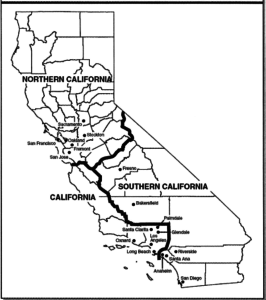Not only is the University of Southern California not in the state of Southern California under Tim Draper’s initiative proposal to divide California into three states, the University of California would no longer be in the state of California. It would reside in the state of Northern California. And, there are plenty of larger issues to be concerned about with the ballot-bound plan to chop California into three states.
Draper announced that he will file enough signatures on his initiative statute to qualify the 3 states plan for the November ballot.
Following his failed effort to qualify a plan to divide California into six states, the investment guru and venture capitalist returned with a plan to carve California up into 3 states: Northern California, which includes the Bay Area, Sacramento and all the counties in the northern section of the state; the state of California (let’s call it New California as a means of clarification) that occupies Los Angeles, Ventura, Santa Barbara, San Luis Obispo, Monterey and San Benito counties; and Southern California taking in San Diego, San Bernardino, Orange, Riverside, Mono, Madera, Inyo, Tulare, Fresno, Kings, Kern and Imperial counties.
Each of these newly proposed states would be in the top ten of all the states in the country as measured by population. However, they would vary widely in economy as gauged by per capita income. Northern California would rank second only to Connecticut, while (New) California would be 12th, and Southern California 30th out of the then 52 states. Northern California would have the strongest tax base, as measured by individuals in that proposed state paying more in income, sales and property taxes under the current tax system.
Draper argues on the Cal 3 website that creating three states would promote a sense of community and culture within each of the states. He says California education status and tax laws would improve and powerful special interests (he takes a swipe at the teachers’ union) would lose influence.
On the business front, Draper claims that fashioning business regulations that meet the needs of the specific regions will improve the economic climate. “The economic climate in areas like San Bernardino and Fresno is very different from the economic climate in areas like Los Angeles and San Francisco. Dividing California into smaller states will help elected officials decide which laws and tax regulations best suit that specific region.”
If the three states proposal is approved by voters, maneuvers through a thicket of expected lawsuits and gets approval of congress and the president, the three new California states would set off on a wild adventure of writing new constitutions, dividing up assets and debts and creating all kinds of regional battles.

If you think the water issue is difficult now, wait until the state of Northern California is in control of major water sources. The Delta Tunnels plan will disappear. Poor Southern California will be stuck with the high-speed rail.
The wealthy state of Northern California also has the smaller percentage of MediCal patients. How will the less wealthy state of Southern California meet the needs of its MediCal constituents? Or would the MediCal rules be drastically changed by the new legislatures in each new state?
Speaking of law changes, two stalwart ballot measures that have guided taxes and funding in California (old California, that is) over the last three decades would be gone. No more Proposition 13 to protect property taxpayers. No more Proposition 98 to dictate school funding…unless the constitutional convention in each state reinstates them and voters approve.
There are plenty of reformers or special interests who would welcome the opportunity to start fresh on both those issues. But with opportunity comes risks of not knowing what new tax and spending plans would look like.
Political scientists might have a field day in proposing new government structures but I suspect voters would be more circumspect.
Discussing and debating the creation of new states might be interesting and fun but the hurdles are so high it appears unlikely the 3 states will become a reality. In the meantime, focus will be taken away from needed debates on how to overcome some of California’s current challenges.
The Legislative Analyst’s Office reviewed the obstacles of implementing the three states proposal. You can find the LAO paper here.

